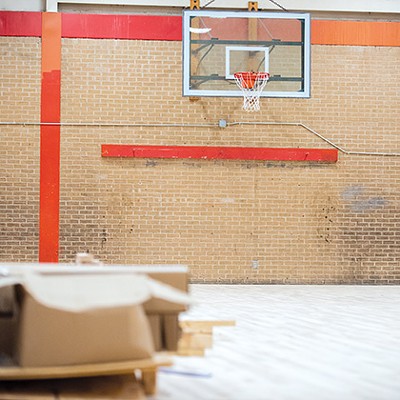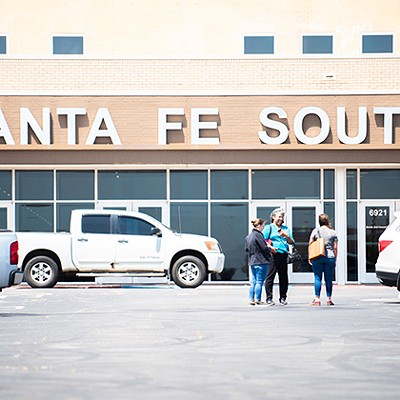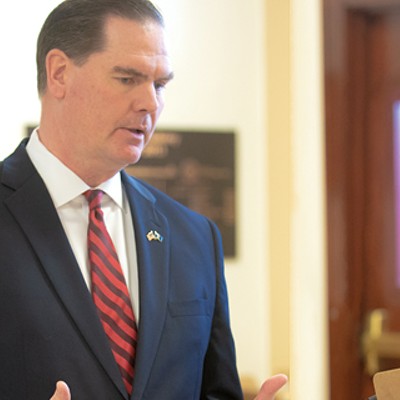Seventy-five percent of African-American male high school students in the Oklahoma City Public Schools district were suspended at least once in 2012.
It’s the highest rate in the nation.
Forty-five percent of all high school students in the district were suspended during the same year, which is the nation’s 10th-highest overall rate.
With evidence supporting a direct connection between suspensions and dropouts, incarceration, poverty, low academic performance and unemployment, OKC is losing a generation of young people like almost no other city in America.
“It should shock our conscience, and it should prompt action,” said Dan Losen, director of the Center for Civil Rights Remedies, a social research firm that recently released a report showing suspension rates for every American school district.
New district leadership arrived last year with a long list of challenges, but the unprecedented suspension rate must be addressed before any substantial reform can take place in the state’s largest district.
“It’s alarming,” said Superintendent Rob Neu, who was hired last year. “We knew that we had discipline issues in the district, but those numbers are alarming and have to be a priority for the district.”
Neu said reversing suspension trends requires policy and procedural changes, but he also believes some changes can take place immediately just by recognizing the problem.
It’s a belief Losen shares, too.
“We can’t fix what we don’t talk about,” Losen said. “It is really important that we think about what is happening in the school environment, and these suspension numbers are good indicators.”
‘Bad kids’
Tenth-grader Jashon Lawrence isn’t surprised to hear his district has one of the highest suspension rates in the nation.“I guess we have a lot of bad kids,” Lawrence, a Northwest Classen High School student, said when asked his thoughts.
Critics of suspension-heavy policies say removing troubled students from schools without exploring other disciplinary options sends a message that schools like those here are full of “bad kids.”
The district’s high rate impacts school performance and society as a whole.
“We must interrupt the pernicious school-to-prison pipeline that starts with black and brown boys being disciplined excessively and harshly, causing them to think of themselves as ‘bad kids,’” Jonah Edelman, co-founder of Stand for Children, wrote in a column for The Daily Beast last year. “This is the No. 1 civil rights issue of our time.”
Statistics back up Edelman’s claim, including the fact that Oklahoma has the second highest African-American incarceration rate in the nation, according to a study by the University of Wisconsin-Milwaukee. In fact, states like Wisconsin, Iowa, Pennsylvania and Oklahoma — which have some of the highest African-American suspension rates in the nation — also are home to some of the highest black incarceration rates. This connection implies that states where schools suspend large numbers of black students also lock up large numbers of black adults.
While not as high as the male rate, black female students are suspended at a higher rate (54 percent) than their white peers (25 percent). Like male students, females also face a higher risk of incarceration after being suspended.
“The single largest predictor of later arrest among adolescent females is having been suspended, expelled or held back,” wrote Johanna Wald in Deconstructing the School-to-Prison Pipeline: New Directions for Youth Development, citing a 2001 report by the American Bar Association.
Suspensions and harsh disciplinary measures in high schools have been blamed for the so-called “school-to-prison pipeline,” a phrase Neu has used in the past, especially when discussing the underperformance of the district’s minority students.
“We’ve got a problem,” Neu told the school board in December. “Our African-American students are dying on the vine, and if we don’t do something to intervene right now, we know their pathway.”
In an interview with Oklahoma Gazette last week after the release of the report listing the district as top in the nation for black male suspensions, Neu reiterated the seriousness of the issue. While he cautioned that the data is two years old, he said discipline must be a focus for district leadership.
“There are a lot of priorities for the district, but this is a top priority because when you are suspending students, their chances of being successful and graduating greatly diminishes,” Neu said.
Neu also said the way a school disciplines students greatly affects their self-value and how they view their community. It’s a reality that Lawrence, the Northwest Classen student, embodied when asked if he really thought OKC schools have “a lot of bad kids.”
“I don’t know,” said Lawrence, before taking a long pause to offer his own question. “What else would those [statistics] mean?”
Trending up
Data from the district for the 2012-13 school year shows signs that suspension numbers might have fallen slightly from the school year tracked in the Center for Civil Rights Remedies report. Regardless, the district remains one of the highest suspending school systems in America.The U.S. Department of Education noticed the high minority suspension rate. too. Last year, it launched an investigation into the matter. District leadership cooperated with the Department of Education’s investigation by submitting additional data, according to Brandon Carey, attorney for the district.
“We are just waiting to hear back from them,” Carey said.
However, if suspension rates have fallen in the last two years, it would be a stark change from the several years before, as rates trended up.
The district’s elementary-level suspension rates increased from 7.2 percent in 2010 to 13 percent to 2012, according to the same report from the Center for Civil Rights Remedies. High-school suspension rates increased from 25 to 45 percent during that time period.
Also, suspension rates for all racial groups increased during those years, and the gap between white and black student suspensions increased to 31 percent.
One obstacle in decreasing suspension rates might be its lack of a dedicated staff position to oversee discipline policies.
“We need a person who can focus on that,” said Teri Bell, executive director of student support services, the department that oversees disciplinary issues.
Bell said the district’s student services department was reduced from four staff members to two in 2001 and has never been replaced. Aurora Lora, OKC’s associate superintendent, said that even with a return to four staff members, the district would still lag behind most school systems of similar size.
“We need a dedicated person looking at this issue because that’s what you find in districts our size and smaller,” she said.
Success stories
Oklahoma City is hardly the only urban school district to deal with high suspension rates. While percentages have risen locally, some school districts across the country have shown improvement after employing various plans.The San Francisco public school district cut its suspension rate in half last year after expanding support programs to address student behavior. The rate of minority suspensions also fell from 1,063 black suspensions in the 2011-12 school year to 576 in 2013-14. Latino suspensions fell from 698 to 344 during the same time period.
The International Institute for Restorative Practices (IIRP) works with districts, including those in Pittsburgh, Pennsylvania, and Minneapolis, Minnesota, to discover methods for reducing suspension and discipline issues.
“We focus heavily on building trusting communities between teachers and students,” Keith Hickman, assistant director of continuing education for the IIRP Graduate School, told Oklahoma Gazette. “We get teachers to express their feelings, and this is all really important ... because we believe the healthiest environments for human beings are ones where there is free expression.”
Big Picture High School in Seattle was recently profiled in The Seattle Times for its use of restorative practice in an effort to reduce suspensions through a philosophical change in which “rule breaking is now treated as harm done to a relationship ... rather than a reason to mete out punishment.”
An example of this type of shift, as reported by the Times, includes three female students suspected of smoking marijuana, an infraction that would have normally resulted in suspension.
“Instead of sending the three smokers home with a litany of their failings, [the principal] sat face-to-face with each, explaining what it felt like to have his trust violated,” Times reporter Claudia Rowe wrote. “He read them testimony from other teachers, who spoke of their belief in the young women — how they had a chance to go to college, build a career, leave their difficult family lives behind.”
Taking a calmer and more reasoned approach to discipline issues sounds easy but can be a challenge for teachers.
“Everyone wants the superhero teacher from Hollywood, but everyone can’t be that,” said John Thompson, a former Oklahoma City teacher and current education writer who has contributed to This Week in Education, School Matters and Oklahoma Gazette.
Thompson said the struggle in an urban district like OKC’s is that students bring baggage with them from home and discipline issues are often expressions of the pain they feel. Learning how to deal with that expression, Thompson said, is the key, rather than just being less trigger-happy with suspensions.
“There’s nothing easier than criticizing the Oklahoma City Public Schools,” Thompson said. “On the other hand, compare the sincerity and professionalism of the Oklahoma City administrators with what we see in everyday life and they come off really looking pretty good. The compassion and desire is there; the training and planning is not.”
The district’s leadership is still less than a year old, so the statistics of the past might be unfair to peg on the current superintendent and his team.
But with the recent report and the ongoing U.S. Department of Education investigation, district leadership is well aware of the issue and must look for ways to remedy it.
“I think recognizing that you have a problem is the first step to fixing it,” said Ryan Kiesel, executive director of the Oklahoma chapter of the American Civil Liberties Union (ACLU).
ACLU chapters in other states have confronted districts over disproportionate suspension rates among minorities, and while a local legal challenge has not been launched, Kiesel said his office is monitoring OKC’s situation.
“It’s not easy to come to grip with numbers that tell a difficult story like this about our district,” said Kiesel, who also said he is optimistic about the direction in which the new superintendent is moving. “My hope is that the school district ... can get to a point where school suspension is used rarely across the board, but particularly in its disproportionate application. This has to change.
Print headline: School-to-prison pipeline?, Studies show that OKC school suspension rates are among the highest in the nation. New district leadership addresses ways to correct the problem.












